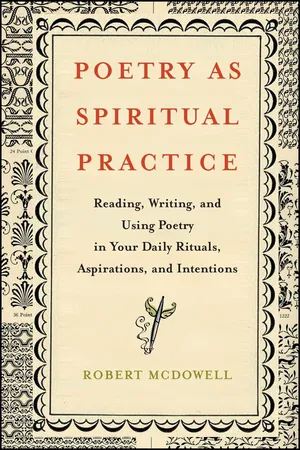
Poetry as Spiritual Practice
Reading, Writing, and Using Poetry in Your Daily Rituals, Aspirations, and Intentions
- 272 pages
- English
- ePUB (mobile friendly)
- Available on iOS & Android
Poetry as Spiritual Practice
Reading, Writing, and Using Poetry in Your Daily Rituals, Aspirations, and Intentions
About This Book
"[When we read and write poetry, ] it is as if a long-settled cloud in our mind suddenly dissipates, and we are divine once again." -- from the Introduction Poetry is the language of devotion in prayer, chant, and song. Reading and writing poetry creates clarity, deepens and expands spiritual inquiry, and cultivates wisdom, compassion, self-confidence, patience, and love. In author Robert McDowell's words, poetry makes you into a tuning fork of the Divine. But poetry has disappeared over the centuries from religious ceremonies, academic curricula, and public discourse. In Poetry as Spiritual Practice, the first inspirational and instructional guide to combine poetry and spirituality, McDowell restores poetry as the natural language of spiritual practice and invites you to recognize poetry as "the pure sound and shape of your spirit." Vividly illustrated with a wide range of poems from all historical eras and poetic traditions, numerous religions and faiths, and McDowell's own and his students' work, Poetry as Spiritual Practice will reintroduce you to the unique pleasure of verse. And meditations throughout will allow you to integrate reading and writing poetry into your spiritual journeys and daily life. Since many of us have long forgotten, or never learned, the mechanics and terminology of poetry -- trochaic feet and tropes trip us up; we can't tell a villanelle from its shorter cousin, rondeau; and a terza rima may as well be a tanka -- this is also an instructional handbook on reading and writing poetry. An engaging guide through the landscape of world poetry, McDowell argues along the way for the many practical benefits of poetic literacy. Making poetry an essential part of daily rituals, aspirations, and intentions will put you on the path to greater meaning, growth, and peace in your life. At once an engaging technical primer, a profound meditation on the relationship between poetry and the Divine, and an inspirational guide for integrating poetry into spiritual practice, Poetry as Spiritual Practice will become a cherished companion.
Frequently asked questions
Information
Three
Forms for Practice
8
Haiku: Perfection of a Seed
Table of contents
- Cover
- Colophon
- ALSO BY ROBERT MCDOWELL
- Title Page
- Copyright
- Dedication
- Epigraph
- Contents
- Introduction
- One: The Shape of Practice, the Mystery of Poetry
- Two: Building Blocks
- Three: Forms for Practice
- Four: Three Genres for Practice
- In Closing
- Poems Included as Illustrations Within Chapters
- Acknowledgments
- Permissions
- About the Author